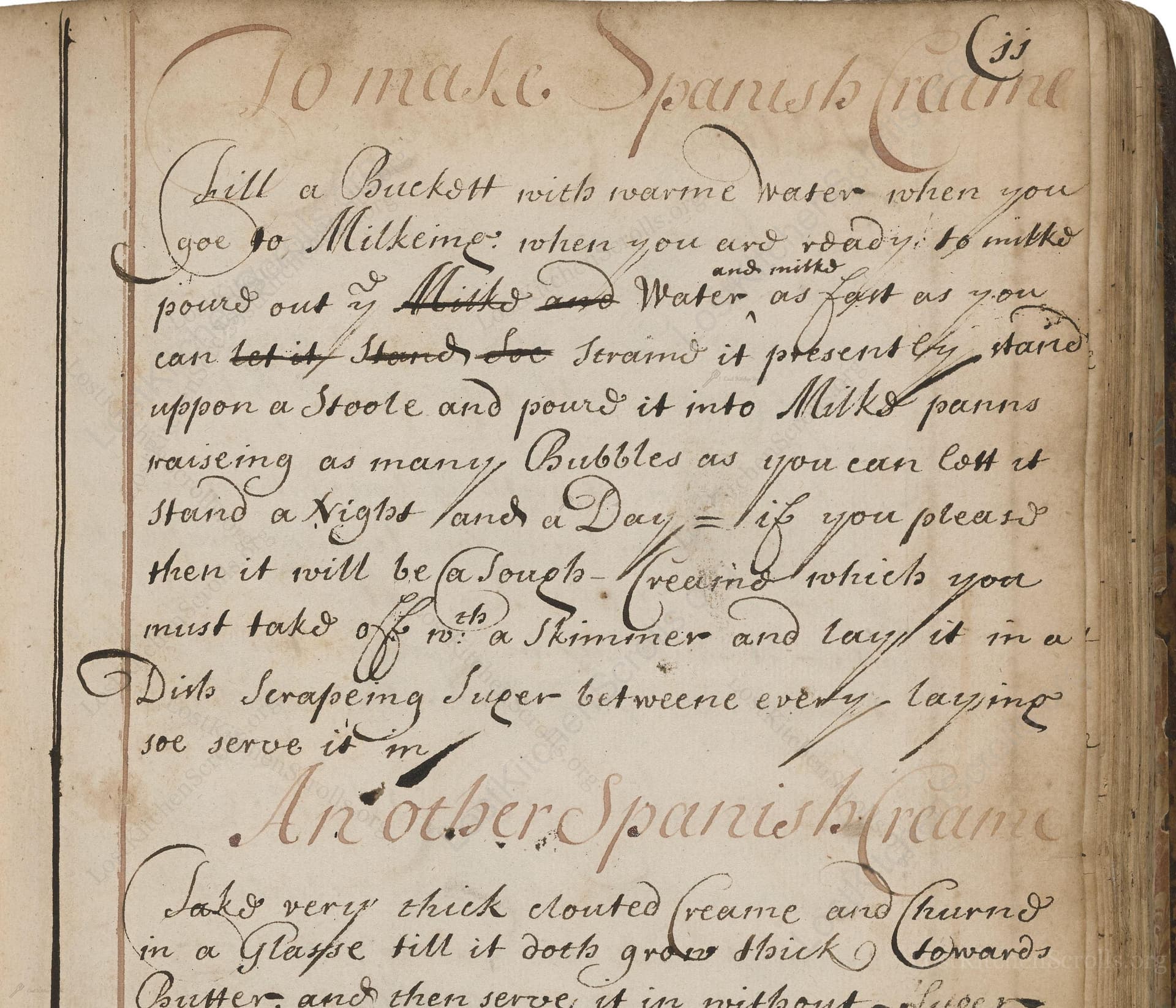To Make Spanish Creame
From the treasured pages of Cookery and medicinal recipes by Kendall Rose and Anne Cater
Written by Rose Kendall, Anne Cater, Elizabeth Clarke, Anna Maria Bold

To Make Spanish Creame
"Fill a Buckett with warme Water when you goe to Milkeing: when you are ready to milke and milke pourd out 2/3 Milke and Water as fast as you can let it Stand and straind it present ly stand uppon a Stoole and pour it into Milke panns raiseing as many Bubbles as you can lett it Stand a Night and a Day - if you please then it will be a Tough Creame which you must take off with a Skimmer and lay it in a Dish Scrapeing Suger betweene every laying soc serve it in"
Note on the Original Text
Seventeenth- and eighteenth-century recipes were written as brief, experience-based instructions, favoring process over precise measurement. Quantities are often implied or relative to the size of one’s household or the batch needed—no scales or standardized cups in sight! The spelling is phonetic and reflects the non-standardized English of the period: 'straind' for 'strained,' 'milke' for 'milk,' 'stoole' for 'stool.' Writers expected the cook to be familiar with the rhythms of dairying, such as milking, creaming, and the overnight separation required. The playful exhortation to 'raise as many bubbles as you can' reveals both the physicality and practical know-how expected of cooks in early modern homes.

Title
Cookery and medicinal recipes by Kendall Rose and Anne Cater (1712)
You can also click the book image above to peruse the original tome
Writer
Rose Kendall, Anne Cater, Elizabeth Clarke, Anna Maria Bold
Era
1712
Publisher
Unknown
Background
Step into the inviting kitchens of the past with this enchanting collection of culinary wisdom from England's early modern era. Crafted by a talented array of women, this book promises savory pies, sweet confections, and secret family recipes—an aromatic tour through centuries-old feasts sure to delight the curious palate.
Kindly made available by
Folger Shakespeare Library
This recipe for 'Spanish Creame' comes from an English household manuscript compiled sometime between 1675 and 1750, with contributors like Rose Kendall, Anne Cater, and Elizabeth Clarke. This period was marked by elaborate dairy recipes and experiments with new culinary techniques introduced from abroad, yet adapted to local English tastes. Milk was sourced directly from farm animals, and fresh cream desserts were a luxury for those who had access to regular dairying. ' Spanish Cream' doesn’t directly relate to Spain but borrows continental methods of creaming and serving enriched dairy preparations for the English table. The dish reflects both the ingenuity and opulence found in the kitchens of prosperous early modern English households.

The original preparation required large wooden or metal buckets for holding water and milk, sturdy stools to gain height for pouring (essential to aerate and create bubbles), broad shallow milk pans for resting and separating cream, a simple strainer for removing solids, and a flat skimmer to lift the set cream. In a modern kitchen, these correspond to deep mixing bowls, a mesh sieve, wide baking trays or shallow pans, and a large slotted spoon or flat spatula.
Prep Time
15 mins
Cook Time
0 mins
Servings
8
We've done our best to adapt this historical recipe for modern kitchens, but some details may still need refinement. We warmly welcome feedback from fellow cooks and culinary historians — your insights support the entire community!
Ingredients
- 2-2.5 quarts fresh whole milk (preferably non-homogenized)
- 4 quarts warm water
- 1/2-2/3 cup granulated sugar (to taste)
Instructions
- Begin by heating about 4 quarts of water until it is warm, not boiling.
- Place this water in a large clean bucket.
- As soon as you are ready to harvest fresh milk (ideally unpasteurized and whole for authenticity), start milking or pouring 2 to 2.5 quarts of milk quickly into the warmed water.
- Stir gentley to mix and allow it to sit undisturbed until any solids settle.
- Next, strain the mixture immediatly to remove any clumps.
- Then, carefully pour the liquid from a height into wide shallow pans, aiming to create as many bubbles as possible.
- Let these pans sit uncovered in a cool place for 24 to 36 hours.
- After this time, a thick, tough cream layer will have formed on the surface.
- Using a skimmer or flat spoon, gently lift the layer of cream and transfer into a serving dish, sprinkling sugar between each layer.
- Serve as a sweet, rich treat.
Estimated Calories
350 per serving
Cooking Estimates
You will spend about 15 minutes preparing and mixing the milk and water, a few minutes straining and pouring, and then the cream needs to sit for about 24 to 36 hours to form. After that, you just skim and serve. Each serving is rich and sweet, so the calories are an estimate for a typical portion.
As noted above, we have made our best effort to translate and adapt this historical recipe for modern kitchens, taking into account ingredients nowadays, cooking techniques, measurements, and so on. However, historical recipes often contain assumptions that require interpretation.
We'd love for anyone to help improve these adaptations. Community contributions are highly welcome. If you have suggestions, corrections, or cooking tips based on your experience with this recipe, please share them below.
Join the Discussion
Rate This Recipe
Dietary Preference
Main Ingredients
Culinary Technique
Occasions

Den Bockfisch In Einer Fleisch Suppen Zu Kochen
This recipe hails from a German manuscript cookbook compiled in 1696, a time whe...

Die Grieß Nudlen Zumachen
This recipe comes from a rather mysterious manuscript cookbook, penned anonymous...

Ein Boudain
This recipe comes from an anonymous German-language manuscript cookbook from 169...

Ein Gesaltzen Citroni
This recipe, dating from 1696, comes from an extensive anonymous German cookbook...
Browse our complete collection of time-honored recipes



